Key takeaways:
- Public hearings amplify diverse voices, creating genuine dialogue that humanizes policy discussions.
- Personal narratives shared during hearings can shift perspectives and highlight systemic issues in the community.
- Active listening and emotional vulnerability foster connections, enhancing effective engagement in public discussions.
- Establishing a collaborative tone encourages constructive exchanges and mutual respect among participants.
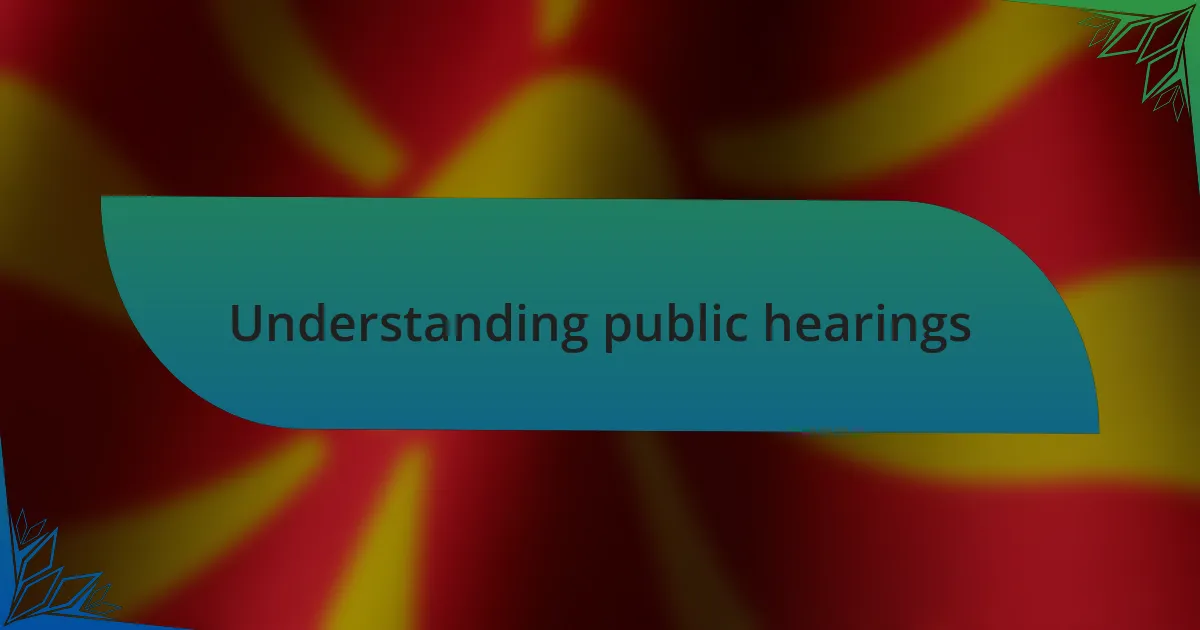
Understanding public hearings
Public hearings serve as a critical platform for citizens to engage with government processes. I remember attending one where I was struck by the diverse backgrounds of people who spoke. It made me realize how these gatherings can amplify voices that might otherwise go unheard. How often do we get a chance to stand in front of decision-makers and articulate our concerns directly?
The atmosphere in these hearings can be electric, filled with tension as individuals share their personal stories. I recall a woman passionately advocating for environmental protection; her tears underscored the stakes involved. It dawned on me that public hearings are more than just formal proceedings; they are deeply human moments where emotions collide with policy and decisions.
As I observed various perspectives clashing, I couldn’t help but think about the importance of transparency. When community members confront officials, are they offering more than just their opinions? They bring forward lived experiences and emotions that humanize the often dry and technical nature of legislative work. This connection between individuals and policymakers makes public hearings a unique avenue for genuine dialogue.
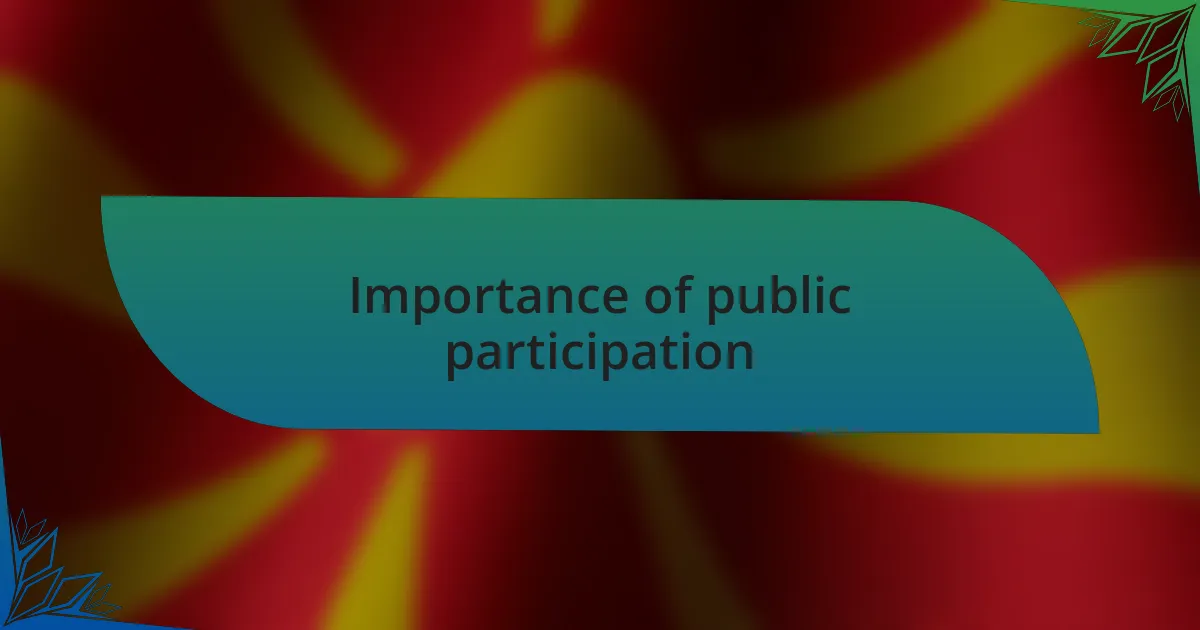
Importance of public participation
Public participation in hearings is vital because it elevates the collective voice of the community, making it an essential element of democracy. During one hearing I attended, a young man spoke about his struggles finding affordable housing. His heartfelt plea resonated with many, illustrating how firsthand experiences can highlight systemic issues that statistics alone cannot capture. Isn’t it incredible how a single story can spark a shift in perspective among decision-makers?
I often think about the power of community engagement in shaping policies that affect us all. At another hearing, I witnessed a heated discussion on local school funding, where parents and teachers expressed their frustrations and hopes. The palpable passion in the room reminded me that these moments are not just about winning an argument; they are about forging connections and fostering understanding. Isn’t that a crucial part of building a more just society?
Moreover, when individuals take the time to participate in public hearings, it encourages accountability among officials. In a recent session, I noticed a council member visibly moved by the testimonies shared. It made me reflect on how public participation can serve as a check on power—reminding those in authority that they are held accountable to the people they serve. The synergy created in these moments is what truly empowers communities, don’t you think?
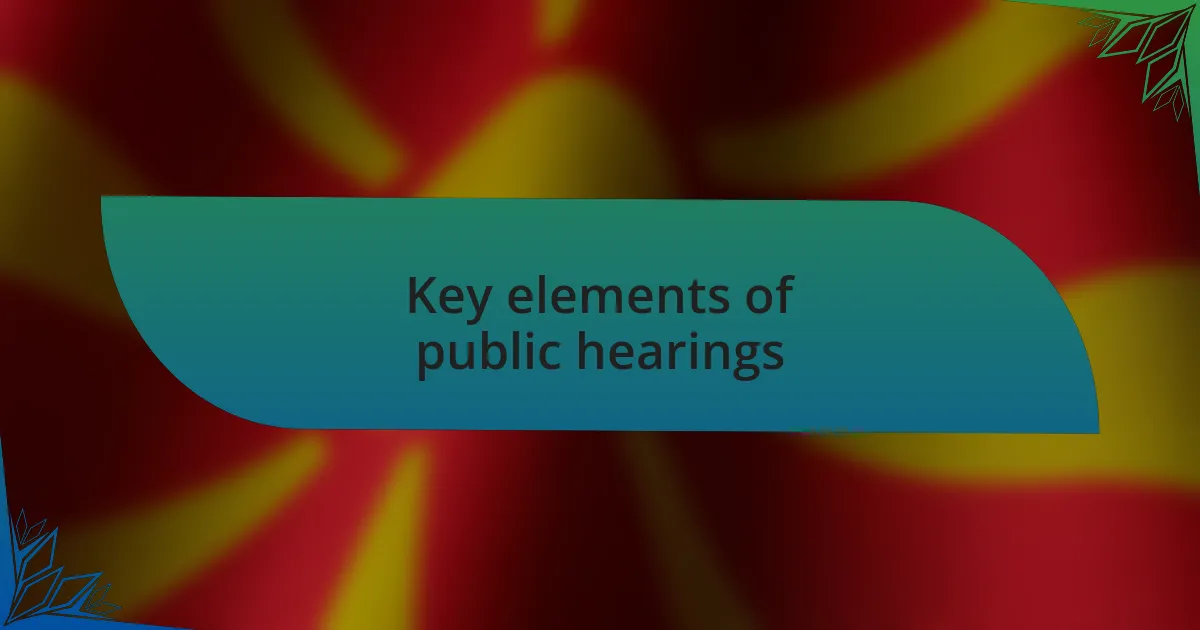
Key elements of public hearings
In any public hearing, clear communication is essential. I recall one session where the moderator established ground rules that clarified the process, ensuring everyone felt comfortable voicing their opinions. This framework allowed for a respectful exchange of ideas, showcasing how structure can empower participants to share their thoughts without fear of interruption.
Another key element is the diversity of voices present at these gatherings. I once attended a hearing where a wide range of community members, from local business owners to activists, shared their viewpoints. It struck me how this mix of perspectives not only enriched the conversation but also ensured that various concerns were recognized and addressed. When we hear from different demographics, we begin to paint a fuller picture of the issues at hand. Isn’t it fascinating how varied experiences can lead to more holistic solutions?
Moreover, the role of officials in public hearings cannot be overlooked. I’ve seen council members take notes intently while listening to testimony, signaling their commitment to understanding community needs. This responsiveness from those in power can create a sense of trust among participants. After all, when officials demonstrate genuine interest in what’s being said, it cultivates an atmosphere where people feel their voices truly matter. Isn’t that a powerful motivator for continued engagement?
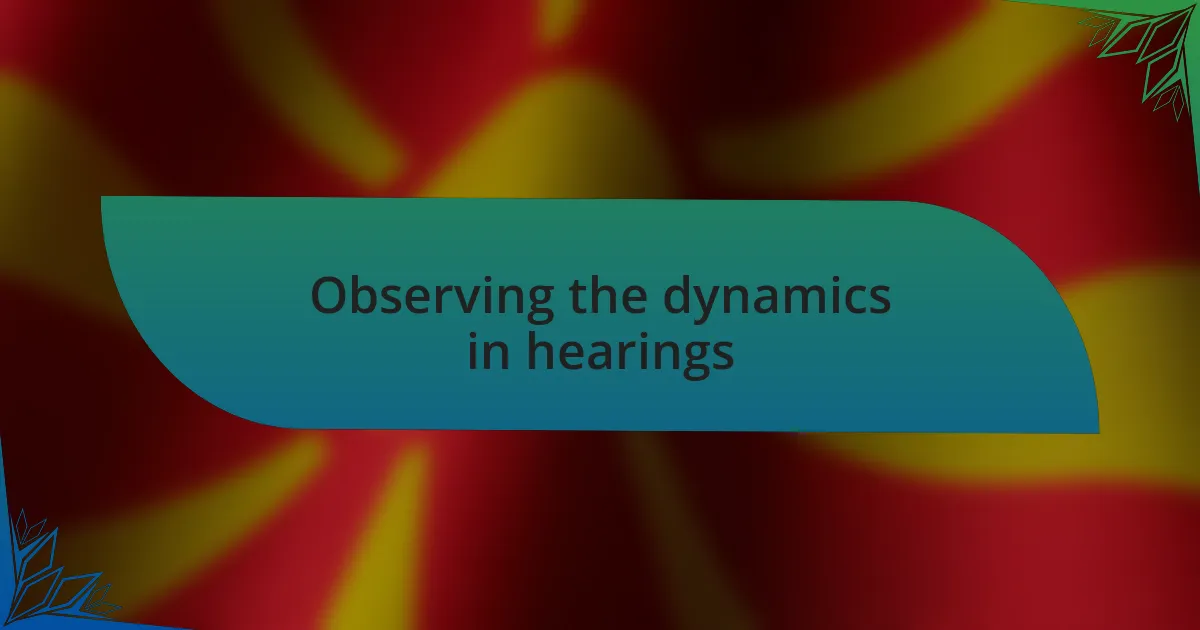
Observing the dynamics in hearings
As I settled into my seat during a recent public hearing, I couldn’t help but notice the palpable tension in the room. You could almost feel the energy shift with each speaker who approached the podium. It became clear to me that the dynamics shifted not just with the content of what was being said, but also how individuals responded to one another’s truths. Wasn’t it striking to witness how a single, heartfelt story could alter the atmosphere, prompting nods of agreement or quiet contemplation among attendees?
A particularly memorable moment occurred when a young student shared her concerns about the local school funding. The way her voice trembled, yet was resolute, made the audience lean in closer. In that moment, I observed an unmistakable connection among attendees, uniting them in empathy and shared purpose. It made me wonder how often we overlook such emotional resonance in discussions—how often does the heart of the matter truly drive the conversation forward?
Additionally, the interplay between opposing viewpoints often created an unexpected rhythm in hearings. During one session, a heated debate erupted between a developer and an environmentalist. What struck me was the clarity that emerged amidst the conflict; each person’s passion revealed deeper community concerns. It was like watching a dance unfold—challenging yet ultimately constructive. Do we not learn more from these moments of friction than from comfortable consensus?
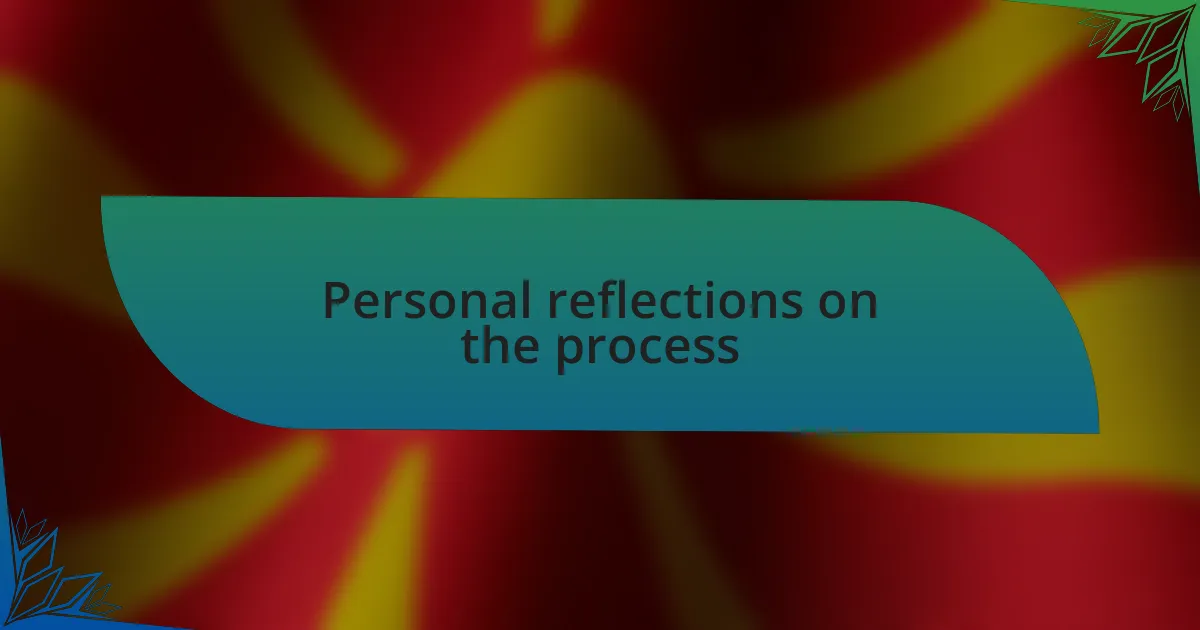
Personal reflections on the process
As I reflect on my time spent in public hearings, I am often struck by the unique tapestry of emotions woven throughout the process. I remember one instance where an elderly resident passionately recounted the history of his neighborhood, each word dripping with nostalgia. His stories were not just personal; they reminded everyone present of the deep-seated connections we share with our communities. Isn’t it fascinating how individual narratives can transform a sterile meeting room into a vivid landscape of memory and hope?
Then there are those moments when the tension reaches its peak, and I find myself holding my breath. I recall a hearing where a local activist faced a panel filled with skepticism. Her unwavering resolve, even in the face of outright dismissal, was nothing short of inspiring. It left me questioning: how often do we all need to summon such courage when advocating for our beliefs? Witnessing her stand firm amidst adversity made me realize the power of conviction—the kind that can shift the course of a discussion.
Moreover, the process itself seems to serve as a mirror for our societal dynamics. I recall a session where opposing views were presented in such a way that each speaker seemed to invite the other into their perspective rather than simply defending their own. It was a refreshing change, reminding me that dialogue can be enriching. Isn’t it a profound lesson that we often learn more from listening than speaking? In those moments, a sense of community began to blossom, one rooted in understanding rather than division.
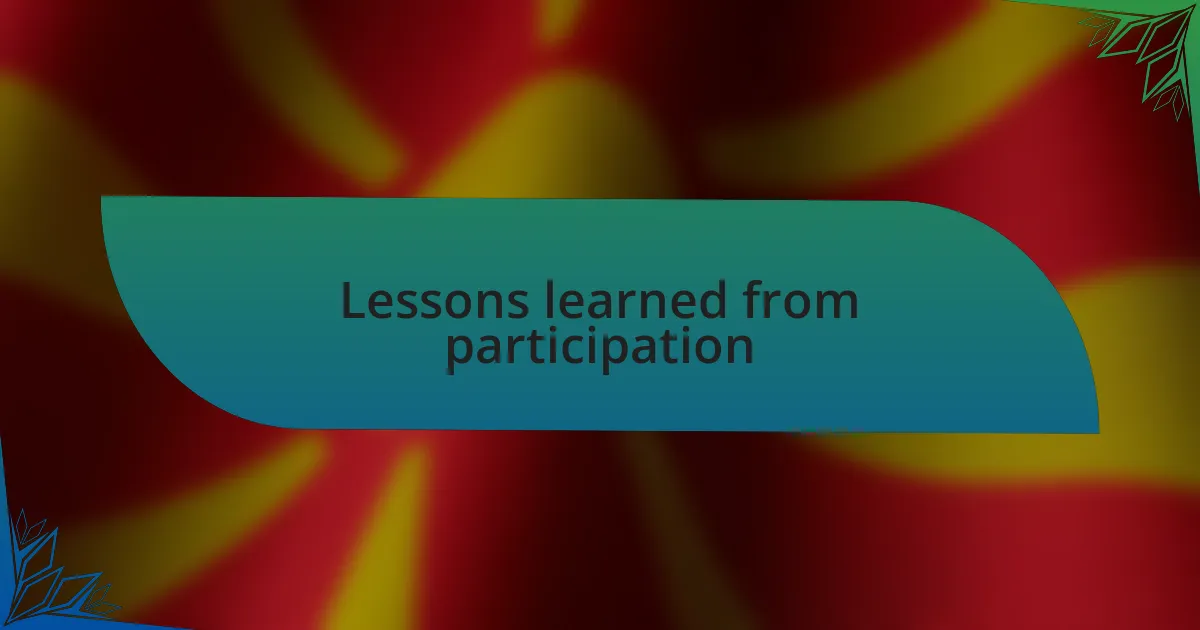
Lessons learned from participation
Participating in public hearings has taught me that every voice matters, a lesson I deeply cherish. I’ll never forget a moment when a quiet individual finally spoke up, sharing an insightful perspective that had clearly been brewing inside for some time. It struck me then—how many valuable ideas remain unspoken simply because people hesitate to share? This realization reinforced my belief in the importance of creating spaces where everyone feels encouraged to contribute.
Another lesson is the impact of preparation on public participation. During one especially heated discussion, I noticed one participant, fully armed with data and anecdotes, commanding the room’s attention. His preparation was evident, and it made me reflect: how often do we take the time to equip ourselves before engaging in important dialogues? Seeing the difference that preparation made inspired me to never step into such settings unprepared again.
As I observed different participants navigate their emotions, I recognized how vulnerability can foster connection. In one session, a mother spoke passionately about the need for safer playgrounds for children, her voice trembling with concern. At that moment, I questioned—how often do we allow ourselves to be vulnerable in public discussions? Her heartfelt appeal highlighted that emotional honesty can bridge divides, inviting others to engage not just with ideas but with their shared humanity.
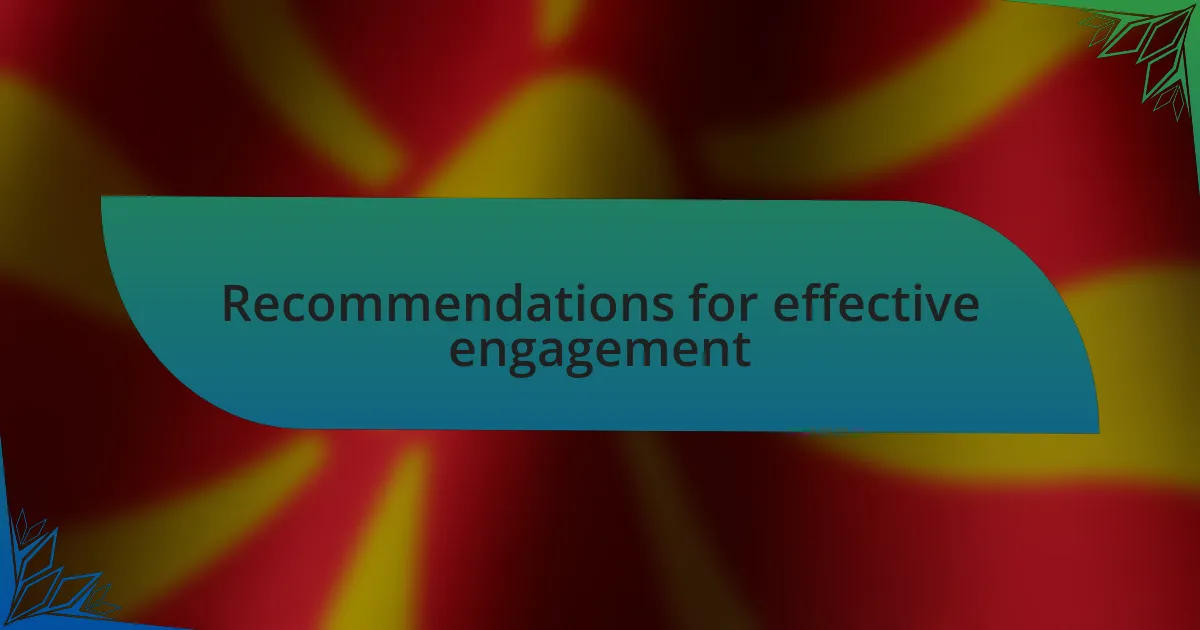
Recommendations for effective engagement
Engaging effectively in public hearings often starts with sharing a personal narrative that connects your perspective to the topic at hand. I once witnessed a participant weave a story about their family’s struggles with local infrastructure issues, and the way it resonated with others was palpable. It made me wonder, how often do we bypass the power of storytelling in our efforts to engage? Authentic narratives can transform abstract topics into relatable experiences, inviting others to empathize and join the conversation.
Another significant aspect of engagement is the art of active listening. During one session, I noticed several participants seemed more focused on preparing their next statement rather than truly hearing opposing viewpoints. This made me think: are we missing golden opportunities for dialogue because we’re not fully present? I learned that by genuinely listening and acknowledging differing opinions, we can create an environment where constructive discussion flourishes, allowing for a richer exchange of ideas.
Finally, I believe setting a collaborative tone is crucial for effective engagement. In a particular hearing, the moderator encouraged participants to build on each other’s thoughts rather than simply opposing them. This approach transformed the atmosphere from confrontational to cooperative. It led me to ask myself, how can we foster a spirit of collaboration in every public discourse? Emphasizing mutual respect and common goals can ignite a shared sense of purpose, driving the conversation toward more productive outcomes.